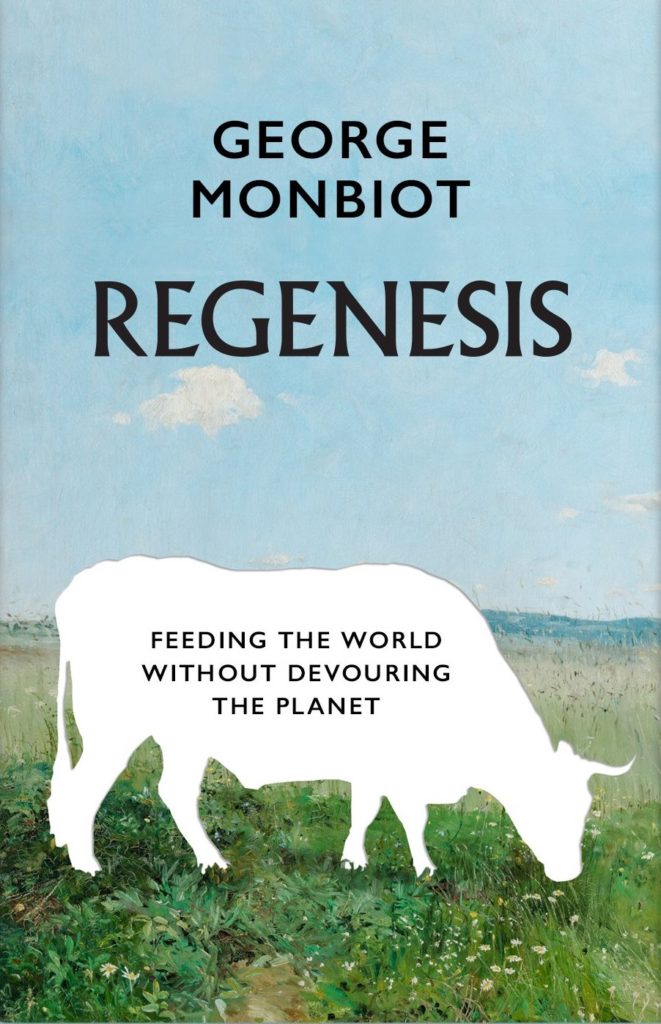In his latest book, George Monbiot takes us from a handful of soil to the prospect of a worldwide Green Revolution — and it’s mind-blowingly exciting, writes Sue Brooks.

There are a handful of books that I have felt excited about in recent years: the frisson of holding a copy in the bookshop for the first time, or seeing it arrive in a brown envelope on the doormat. Feral was one. The paperback version in 2015 with all the turned down corners and annotations. The shock is with me still. I felt as if I had been walking in a sheepwrecked desert. The desert is there, outside the window as I write, but my point of view has changed utterly. And now — Regenesis. Could George do it again…?
Gently, he leads us into his allotment. He turns the soil and looks closely, very closely, using a 40x magnifying loupe, and begins the journey into yet another new world. Two hours and many questions later, he knows how little he knows, except that the future lies underground; in a better understanding of the structure of soil and how it works. It is an explosive beginning — a man down on his knees marvelling at tiny creatures he has never seen before — and I’m hooked.
The language moves quickly into areas that are for me, quite hard to follow — the nodes, modularities, hysteresis and declining redundancies of complex systems — but it’s possible to grasp how close the Global Food System has come to collapse. More new words — Agricultural Sprawl. More strange concepts:
Farming is the greatest cause of habitat destruction, the greatest cause of the global loss of wildlife, and the greatest cause of the global extinction crisis.
Enter: Iain Tolhurst (Tolly). Pioneering farmer of seven acres of rented land in S. Oxfordshire which is 40% stone. In thirty three years of careful observation and keeping a detailed diary, he has increased the fertility of the soil and, at the same time, harvested high yields of vegetables and fruit WITHOUT using fertilizer. George visits the farm over the course of a year, and what at first seemed quite miraculous, fits in with the developing Theory Of Soil he is reading about in the research reports from laboratories around the world. Tolly, through patient attention, intuition and three decades of hard work, shows that it works.
We are close to a Greener Revolution. A mapping of the soil in every part of the world, together with the local climate, could raise our understanding of the twenty first century dilemma — how to produce more food with less farming.
It can be done on a small scale with fruit and vegetables, and also, as two other farmers demonstrate, it can be done with arable crops. Rotational planting of crops and wildflowers to feed the soil and the more-than-human world, but some ploughing and herbicides are necessary and the yields are not as high as Tolly’s.
Enter: Kernza — a new variety of wheat with a phenomenal yield, which is PERENNIAL. It has been researched at the Land Institute at Salina, Kansas. George orders a sample of the flour, and finds, with deep satisfaction, that it bakes well — tasty and nutritious. Already the seed is much sought after in China, because Kernza’s deep roots revitalise soil which has been depleted by centuries of rice growing.
Enter: Apotheosis in Chapter 7. FARMFREE. There are ways of farming without livestock, liberating vast tracts of land for rewilding and carbon capture, BUT, vegetables, fruit and cereal do not constitute a healthy diet for humans. We need protein and fats. Once again, soil has the answer.
Enter: Solar Foods — a Finnish company which is developing a food product from a hydrogen-oxygenating soil bacterium combined with carbon dioxide and water. The first factory will open in 2023, producing food similar to Quorn, which has 60% protein. George is the first person, apart from lab technicians, to sample a pancake made from the dessicated bodies of bacteria. His verdict? As rich as any pancake made with eggs — the beginning of the end of most agriculture. He calls it precision fermentation.
I have tried to give a sense of the drama of reading Regenesis. We know George as a passionate public speaker, as a Guardian columnist, as an environment campaigner, but he is also a superb storyteller. He takes us from a handful of soil to the prospect of a Green Revolution which could rewild the natural world AND feed the global human population. It rings with knowledge and conviction. This is a narrator at full flow, but aware as he was on his knees in the allotment, of the lesson from the soil beneath which lie realities we scarcely imagine. Regenesis 2022 is a beginning. Yes, it is shocking because it lays out other realities most of us choose to ignore, but the possibilities are mind-blowingly exciting.
Back to the publication of Feral, subtitled Rewilding the Land, Sea and Human Life in 2013 and the remarkable way rewild has rooted itself in the culture in less than a decade. Regenesis could do the same. There is much we can do as individuals, right now, to contribute to the movement, but the best of all would be to Read This Book.
*
‘Regenesis: Feeding the World Without Devouring the Planet’ is out now and available here, published by Allen Lane (£18.60).